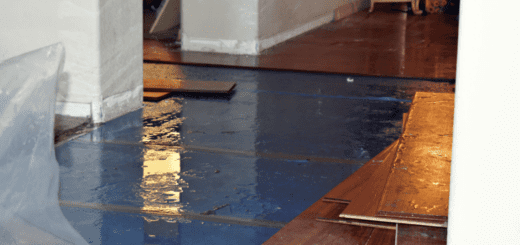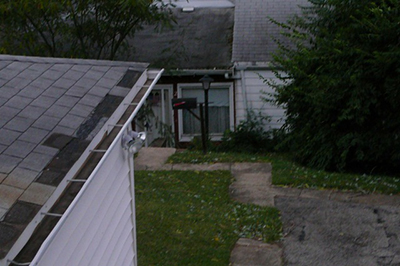How to React to Frozen Pipes
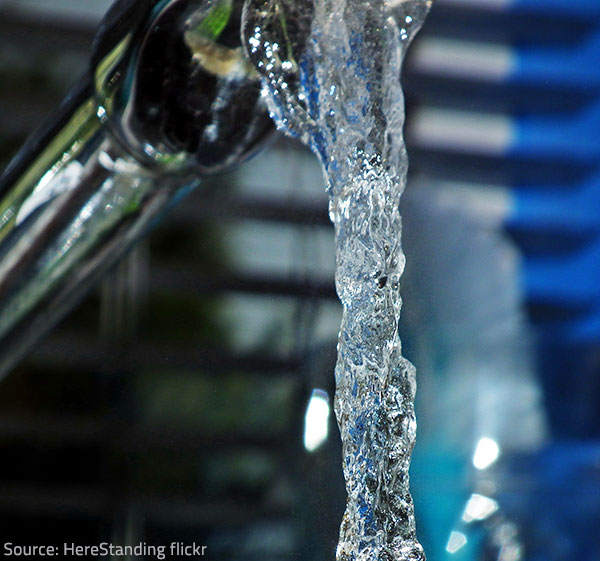
There is nothing more refreshing than the sight of an icicle on the faucet early on the morning.
As soon as the snow starts to fall and the temperatures drop below zero, typical “winter troubles” begin – roads get blocked, people get sick, etc. However, it is hard to believe that the cold weather can at all affect your comfortable lifestyle when you are in your warm and cozy home, sipping a cup of fragrant tea, relaxing in front of the fireplace, or taking a hot shower… unless you are left without electricity due to broken power lines or without water due to frozen pipes. If such unfortunate circumstances occur, there will be nothing you can do to restore the power supply, but you may be able to successfully fix the frozen water pipes. If you take quick and adequate measures, you may unfreeze the pipes before they have burst and caused major damage to your home.
When water freezes, it expands and exerts great pressure on the pipes, causing them to crack and leak. To prevent ruptures and further troubles, you need to thaw the pipes and get the water flowing again as soon as possible. So, if you turn on the faucet on a cold winter day and instead of a steady gush of water only a trickle comes out (or nothing at all), you have no time to waste – your pipes have probably frozen and you need to do something about it real quick. But do you know what to do when water pipes freeze?
How to Locate Frozen Water Pipes
There are lots of pipes in a home, so it is not always easy to find the frozen one(s). To quickly identify the location of the problem, you are advised to:
- Narrow down your search – turn on all the faucets in your home to find out where the problem is:
– If none of the faucets are running, the frozen pipe will be near the water meter. Inspect the exposed pipes in that area – if any of them are coated in frost or feel very cold to the touch, they are probably frozen;
– If water is flowing through one faucet but not through another, you need to examine the pipes running between the two;
- Check risky locations – have in mind that pipes can easily freeze when located:
– in or near crawlspaces, attics, or basements;
– near cold air vents or concrete;
– in an outside wall.
If you can’t find any frozen pipes, but you still get reduced or no flow at a plumbing fixture, you are recommended to call a licensed plumber as the problem may be bigger than it seems.
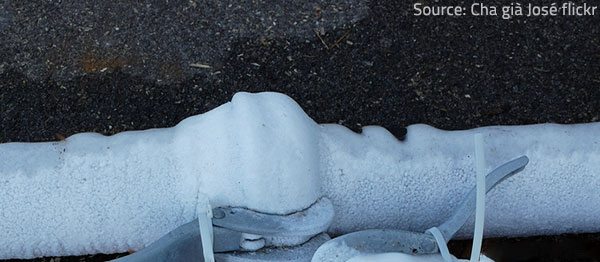
A frozen pipe is likely to be coated in frost.
If you have found the frozen pipe(s), you need to promptly thaw them and prevent water damage to your home.
What to Do about Frozen Pipes
The first thing to do after identifying a frozen pipe is to examine it for cracks and leaks. Take a closer look at the joints, as well as at the back of the pipe, to know for sure if it has already been damaged.
1) If the pipe is ruptured or if you find a leak, however small, immediately turn off the main water valve and call a plumber. Have in mind that the frozen water acts as a plug, preventing water from spilling out of the cracks. Thawing the pipes will result in an outburst of water, causing considerable damage to your property. If this happens, immediately call experienced water damage restoration specialists. They will not only mitigateTo mitigate is to reduce or limit the severity of damage, ri... More the damage but will also assist you with your insurance claims (most homeowners’ insurance policies cover burst pipes and the resulting damage);
2) If there are no leaks or cracks, you should try to unfreeze the pipe as soon as possible.
In order to fix frozen pipes, you need to find the location of the blockage first:
- Look for ice or frosted areas on the surface of the pipe;
- Feel the temperature of the pipe with your hand (or use an infrared thermometer if you have one) to find sections that are significantly colder than the rest of the pipe;
- Tap the pipe gently with a small hard object and listen for the specific solid sound which means that the certain area is not hollow.
Once you know which section of the pipe is frozen and in danger of bursting, follow the tips below to safely unfreeze it.
How to Thaw Frozen Pipes
There are several essential things to remember when thawing frozen pipes:
- Keep the faucet attached to the frozen pipe open and open any nearby working faucets as well. This will help relieve the built-in pressure in the pipe and will allow water to run freely. As you warm up the frozen pipe and the ice inside it begins to melt, water will begin to flow through the frozen area. When running water passes through or near a frozen area, it will speed up the thawing process;
- Heat the pipe from the faucet toward the frozen area, so that the water can easily flow out as the ice melts;
- Never attempt to thaw out frozen pipes by pouring boiling water directly over them or by switching on your immersion heater (or central heating boiler) as the abrupt change in the temperature may cause the pipes to rupture;
- Never use a blowtorch, charcoal stove, kerosene or propane heater, or other open flame devices to warm up your frozen pipes.

Keep the faucets open when thawing your frozen pipes to let water flow freely once the ice blockage has melted.
Thawing an Exposed Frozen Pipe
You have several options when it comes to thawing an exposed pipe:
- Use a hairdryer, a heat lamp, or a small portable space heater – turn on the heating device and run it back and forth along the frozen pipe (work your way from the faucet toward the frozen section). Do not place the heat source directly against the pipe, as uneven or sudden heating can rupture the pipe. This method has proven to be the safest and the easiest one but it takes long to complete;
- Apply heat tape – wrap the tape in a spiral pattern around the length of the frozen pipe (be careful not to overlap it), then plug it into a power source. The temperature is controlled with a thermostatA thermostat is a device that monitors and regulates tempera... More, so you can warm up your frozen pipe slowly and evenly;
- Wrap the frozen pipe in rags soaked in hot water – soak old towels or other thick rags in hot water, ring them out, and wrap them around the frozen section of pipe. Replace them every 10 minutes until the pipe thaws;
- Heat the premises where the frozen pipes are located – elevate the temperature in the room to about 80 °F and position a space heater or a heat lamp near the frozen pipe. The ice in the pipe should melt within a couple of hours.
Whatever method you choose to use, you may add some salt to the frozen drains first (salt lowers the melting point of ice, so it becomes easier to thaw the pipes).
Apply heat until full water pressure is restored and let the faucet run a bit longer until the cold snap has ended.
Thawing a Frozen Pipe behind a Wall
If the frozen pipe is inside a wall or ceiling, you will be faced with a much greater challenge. Try the following tricks:
- Turn up the heating in the premises to about 80°F and open up cabinets and closets to let the warm air circulate. Wait for several hours;
- Use an infrared lamp to heat the section of the wall behind which the frozen pipe is most probably located;
- Use a fan heater to blow warm air into the external vent. If the air inside gets warm enough, it will help melt the ice in your frozen pipe;
- Open up the wall to get access to the frozen pipe and use any of the above-described techniques for thawing exposed pipes to unfreeze it.
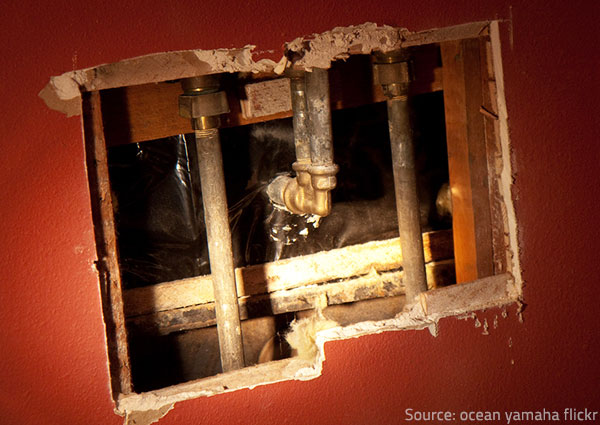
There are several tricks you can try to warm up a frozen pipe that is not exposed before tearing up a hole in the wall.
If you are not sure where the frozen section of the pipe is located, if the frozen area is not accessible, or if you are not up to the task, call a licensed plumber.
In case there has been a leak, consider hiring water damage restoration experts to inspect the affected area and take appropriate measures to prevent moldMold is a type of fungus that grows in damp or humid conditi... More growth and other related problems.
Remember that the best way to avoid the inconveniences and troubles resulting from frozen and burst pipes is to prevent them from freezing in the first place. So, winterizeTo winterize is the process of preparing a building, plumbin... More your home and stay warm and safe throughout the cold season!










